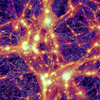


#SimulatedUniverses #AstroPhysicsFactlet
Astrophysicist at Bologna University and https://respublicae.eu/@ERC_Research grantee.
I study the cosmic web, extragalactic magnetism and clusters of galaxies with colorful simulations.
This profile is from a federated server and may be incomplete. Browse more on the original instance.